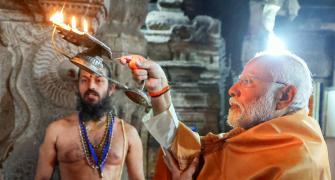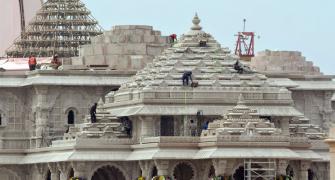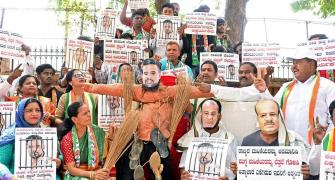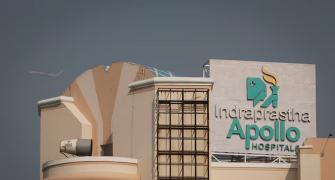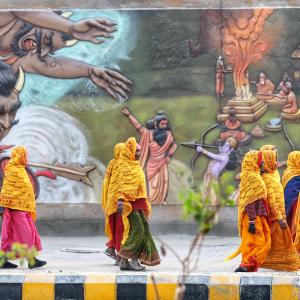Roads are being expanded, bridges are being built, hotels are springing up, and the crowds are pouring in. Bringing with them promise of unforeseen economic boom.
Ayodhya, it seems, has opened up its heart, Saisuresh Sivaswamy/Rediff.com discovers on his first day in the city.
All photographs: Rajesh Karkera/Rediff.com

Two things strike you as you reach Ayodhya's spanking new airport.
One, it resembles a temple more than an airport, which you expect.
Two, it's small, which you don't expect.
Not after the weeks and months of build-up to the small town turned big city aspiring to draw thousands and lakhs every day.
The airport's size, or lack of it, hits you hardest if you are from a metro, where you are used to sprawling airports.




So how big is it?
The concourse has two baggage carousels.
The men's bathroom has 10 urinals in all.
Designed for thousands of tourists, did you say?





Here's another factoid.
There's one prepaid taxi counter manned by two officers. And there aren't enough taxis available. In the considerable time we spent trying to book one (but couldn't), maybe three taxis turned up to ferry fliers.
As you manage to find one outside and head into the dusty countryside, it hits you. The airport, much like the city it serves, is a work in progress.
And the work is going on at a frenetic pace. Roads are being expanded, bridges are being built, hotels are springing up, and the crowds are pouring in. Bringing with them promise of unforeseen economic boom.
A few things are unmissable in the city.
One, of course, is the omnipresence of Prime Minister Narendra Modi, from billboards and cutouts everywhere, leaving you in no doubt who the credit for restoring Lord Ram in his home should go to.
You've read about Modi's presence everywhere, but still, to actually see it, and realise that the reports may have actually underplayed the incidence, is something else. He may not be physically present in the city till Monday, but Modi's presence is everywhere. Especially in his absence.


Gopal from Karnataka, who took his first ever flight when he visited the city, has no hesitation in crediting Modi for the temple. He did what no one had the guts to do, he emphasises.
Bhajan Samrat Anup Jalota too gives Modi fulsome credit for the temple. "Modiji and his friends have really done a great job," he tells us soon after landing in Ayodhya.
A sentiment, you realise, shared by the thousands who are pouring into the city. Airports and planes and roads and trains find hordes raising Jai Sri Ram slogans and conclude by praising Modi as well.
And on Monday, when his helicopter lands, the city, already in throes of ecstasy, will finally exhale.

In anticipation, the city is awash in saffron flags. There are any numbers of stalls and footpath outfits selling saffron banners and standards, and the crowds are happy to sport them as they head to the temple before it shuts for the weekend to prepare for the grand event.

Another thing you cannot miss in the city is the bhandaras that have sprung up everywhere. There are large lines waiting to be fed at these places, and the food doesn't seem to run out. Nor the crowds seem to thin.

Chief Minister Yogi Adityanath has instructed his officials to ensure that no one who comes to the city for the temple inauguration stays hungry, and this seems to have spurred multiple groups into action. Apart from the bhandaras, there are groups serving chai, snacks, even water, to the needy, hungry and thirsty.

Ayodhya, it seems, has opened up its heart.
Nor can you miss the development works that have taken place to ready the city for the temple. The main thoroughfare heading to the mandir has been four-laned, ruthlessly some would say. And the scars can still be seen on many of the buildings; some seem to have their facades done up, not what lies behind it. And quite a few have left the demolished portions undone.
"You will find only one shade of colour used in the buildings," points out Pandey, a driver. The off-white/cream colour is standard issue by officialdom, and the nameboard style has been standardised, in classical style.
Another instruction is that all the buildings must have religion-themed motifs on their shutters -- a from Ram portrait to Om to a bow and arrow, just in case you miss the obvious fact that Ayodhya is a Hindu city.

It is not just a Hindu city, it is also a visibly and audibly a Hindu city, as befits the home of the god-prince. There are devotional songs belted out on streets, groups singing Ram dhun, and temples dotting the landscape lit up. Much of it is for the pran pratishtha on Monday and may be scaled down if not vanish after that, but what will remain is Ayodhya's new status.
And nowhere is it more visible than at the Ram Janambhoomi temple complex. If Ayodhya is a work in progress, its biggest example can be seen in the holy complex.

While much of the work is done and the temple ready for consecration, there is work that visibly remains to be completed. And it's not just the unfinished 2nd and 3rd storeys of the grand temple that is standing tall in silhouette on a dim moonlit night.
It is a large complex and takes a while to reach from the main road. As you walk in as part of the throngs rushing in for a darshan, you realise that all the open, vacant space will be done up in phase two and three.
Right now, what matters is the temple has to be consecration-ready by Monday, which it is. And the city has to be temple-ready, which it more than is.
"Yes, the city has changed beyond recognition," says Kamesh, waiting in line for darshan. "But the worry is, this is all rushing for the consecration. Orders went out to make the city ready for the big day, and it is ready. But has anyone thought of what it will be like on Wednesday and Thursday onwards?"
The general consensus is that thousands will continue to pour into Ayodhya. The small in size but big in concept airport, for instance, is expected to have some 500 taxis soon, to cater to this tourist traffic. All of them e-taxis, as per the chief minister's orders, an officer said.
The worry for the city in the throes of development fever is, what if the promised boom doesn't materialise?


